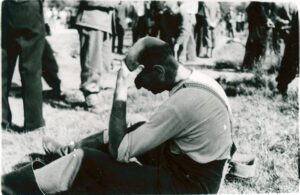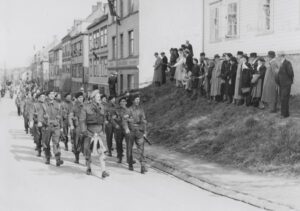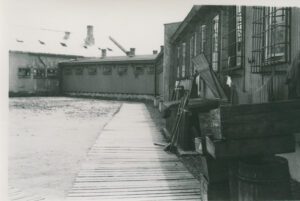Repatriation, or displacement?

In May 1945, all Wehrmacht soldiers suddenly became prisoners of war. Though they survived the war, the journey home posed a new challenge for non-Germans. What awaited them in their homelands? Would they be allowed to return at all? And if so, would they be branded as traitors? Would they face imprisonment? Or should they stay with their former comrades-in-arms and declare themselves German? Perhaps even change their homeland and attempt to build a new life in Germany?
Of all the pre-war Czechoslovak citizens serving in the German military, only about one in ten were recognized for repatriation. Generally, only those who declared a Slavic nationality were permitted to return to their homelands. Once there, they faced additional screening, investigation, and distrust for many years.


With the end of the war, German forces in Norway surrendered. As Allied and Norwegian troops entered the country gradually, it was impossible to take control of the vast number of soldiers, policemen, and various officials all at once. For the first few weeks, therefore, the German administrative and organizational system remained in place.

The Allied authorities meticulously sorted POWs according to their pre-war citizenship, allowing them to apply to their respective national authorities. However, given the conditions in the POW camps, making such applications carried considerable risk. Other captives labeled them as traitors, ostracized them. Physical attacks were not uncommon, and even their lives were at risk.

In the liberated countries, there was widespread animosity towards the Germans. Instances of humiliation and physical attacks were not uncommon. In Norway, POWs were compelled to undertake life-threatening tasks, such as clearing minefields. Thus, even after the war ended, the danger of injury or death persisted for those “non-Germans” who remained with their German comrades.

All pre-war residents of Allied countries were carefully interrogated by specially designated intelligence and repatriation officers. While those of German nationality were allowed to return only in exceptional cases, ethnic Czechs were treated much more favourably. Nationalism was at its peak, and in post-war Europe, nationality often held more significance than an individual’s personal qualities.
If not labelled as “undesirable”, most “non-Germans” returned home with a sense of relief. Yet, some feared punishment and ostracism in their homelands, some chose to stay German identity. Consequently, a number of “non-Germans” decided to start new lives in Germany. In this form, a kind of “Germanization” thus paradoxically continued even after the war.
WHAT TO DO WITH THE ENEMY NEXT?
After the war, the Germans in Norway officially surrendered. However, for the Allied and Norwegian authorities, it was impossible to immediately take control of the vast number of several hundred thousand German soldiers, policemen, civil servants, various employees, and large amounts of material. Under the specific directives of the Allies, the German administration remained in place for a time.
The Germans were instructed to concentrate all their troops in designated areas and prepare detailed personal lists. Additionally, soldiers were to be divided by nationality, prioritizing pre-war citizenship, and concentrated in specific camps. German headquarters promptly carried out these orders, leading to the separation of the majority of Wehrmacht soldiers of “non-German” origin, particularly from annexed territories such as Czechoslovakia and Poland.
All individuals holding Czechoslovak citizenship prior to 1938 were concentrated in special camps, with initial reports indicating 13,500 soldiers. However, the situation with Poland was more complex, as its new borders had yet to be internationally confirmed. Nationality became the key criterion: alongside declared Poles, members of nationally ambiguous Slavic groups—previously targeted by the Nazis for Germanization—were also selected. By October 1945, even after some had been repatriated, over 12,000 Wehrmacht soldiers remained in the “Polish” camps.
In the camps, special officers from the corresponding Allied armies then interviewed all these prisoners, identifying war criminals and collaborators, while also determining who would be granted the “right” to return to their homeland and who would not.
In the case of Czechoslovakia, Poland, and Yugoslavia, ethnic Germans were generally rejected, as the removal of German minorities from these countries had already been decided. However, among the approximately 14,000 soldiers from Czechoslovakia, the vast majority were Sudeten Germans of purely German ethnicity.
Thus, if a soldier wanted to return home, he had to declare himself “non-German,” claiming he had been forcibly conscripted into the Wehrmacht. However, in the initially poorly supervised POW camps, making such a declaration was risky. Although the war had ended, Nazi ideology and loyalty to the Third Reich still lingered in the minds of many POWs. Identifying oneself as a Czech, Pole, Slovene, or Frenchman could lead to insults, threats, bullying, and even physical violence.
Once nationals were gathered in special camps, they were finally able to speak freely without fear. However, they became increasingly aware that their return home depended on demonstrating complete loyalty to their home country. This was compounded by the anxiety over how they would be received upon their return—whether they would face trials, imprisonment, or harsh penalties for their perceived “betrayal.” Additionally, Nazi propaganda about life under Soviet rule had left a deep and lasting impact.
As a result, instead of giving truthful accounts, prisoners often adopted a survival strategy. Those hoping to return home denied their German identity, downplayed their service in the Wehrmacht, concealed any ranks or decorations they had earned, and emphasized that they had been conscripted by force.
Others, on the other hand, found their new background in the German environment and especially in their military units during the war years. Together with the fear of reprisals at home, they chose to embrace a German identity and opted to be deported to Germany.
A gradual repatriation process followed. Since the majority of POWs from Czechoslovakia were Sudeten Germans, only about one-tenth of the former German soldiers successfully passed through the screening and were repatriated, along with other Czechoslovaks who had been brought to Norway by the war. However, upon returning home, they soon discovered that they were stigmatized as traitors and held guilty. The process of returning home proved to be far from easy.
Those “non-Germans” who claimed a German identity were the last to leave Norway. Along with other German POWs, they were assigned to various tasks, including clearance, construction, and relief work, some of which were very dangerous, such as clearing minefields. They endured inadequate food, clothing, and accommodation, and often faced harsh treatment from guards, frequently in violation of the Geneva Conventions on POWs. Only after a prolonged period were they able to reach war-torn Germany, where they slowly and with great difficulty began to rebuild their lives in a new environment, far from their families and loved ones.


